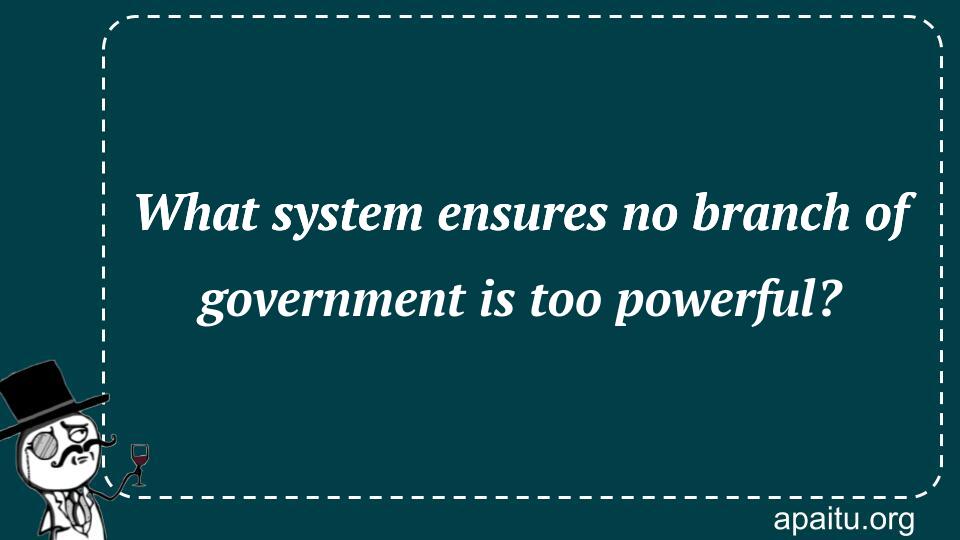Question
Here is the question : WHAT SYSTEM ENSURES NO BRANCH OF GOVERNMENT IS TOO POWERFUL?
Option
Here is the option for the question :
- Parallel obstruction
- Checks and balances
- Proportional restraint
- Vetoes and harmony
The Answer:
And, the answer for the the question is :
Explanation:
Each of the three branches of the U.S. government has the power to restrain the other branches using checks and balances, a system designed to prevent any one branch from taking over. For instance, the President is responsible for making nominations for federal officials, such as members of the Cabinet and judges, but the Senate must give its consent to each nominee. And while the federal courts have the authority to rule that laws and actions taken by the president are unconstitutional, Congress has the power to amend the Constitution in order to change the way the courts interpret the document.

Checks and balances, an integral part of democratic systems, serve as a safeguard to prevent any single branch of government from becoming too powerful. This system, rooted in the principles of separation of powers, ensures a delicate balance of authority and promotes accountability within a government. By distributing powers among the legislative, executive, and judicial branches, checks and balances create a framework that protects the rights and liberties of citizens while fostering a system of accountability and transparency.
The concept of checks and balances traces its roots back to the ideas of political philosophers such as Montesquieu, who emphasized the need to prevent the concentration of power in the hands of a few. In a system of checks and balances, each branch of government possesses certain powers and authorities, but no branch holds absolute control. This fundamental principle serves as a vital check against potential abuses of power and helps maintain the integrity of the system.
The legislative branch, often represented by a parliament or congress, holds the power to make laws and represents the voice of the people. It acts as a check on the executive branch by overseeing its actions, scrutinizing policies, and holding the government accountable. Through the power of impeachment, the legislative branch can remove executive officials who are found to have abused their authority or violated the law. Additionally, the legislature can pass laws that limit the executive’s power or allocate resources, serving as a crucial check on potential overreach.
The executive branch, headed by the president or prime minister, is responsible for implementing and enforcing laws. However, this branch is also subject to checks and balances to prevent the accumulation of excessive power. The judiciary, an independent branch of government, ensures that executive actions adhere to the constitution and the rule of law. The courts have the authority to declare executive actions unconstitutional, providing a check on any potential abuse of power by the executive branch. Furthermore, the executive is accountable to the legislature, which can investigate and question the executive’s decisions and policies.
The judicial branch, comprising the courts and judges, plays a crucial role in checks and balances. Through the power of judicial review, the courts have the authority to interpret laws and determine their constitutionality. This power allows the judiciary to check the actions of the legislative and executive branches, ensuring that they align with the principles and values enshrined in the constitution. By providing an independent and impartial assessment of government actions, the judiciary acts as a vital safeguard against the concentration of power.
The system of checks and balances promotes transparency and accountability within a democratic governance structure. It ensures that no branch of government can act without scrutiny or without being held accountable for its actions. The separation of powers, combined with checks and balances, creates a robust framework that allows for collaboration between branches while preventing the dominance of any single branch.
other institutions and mechanisms contribute to the checks and balances system. Independent agencies, such as regulatory bodies, act as a check on both the legislative and executive branches by overseeing specific areas of governance and ensuring compliance with laws and regulations. The media also plays a vital role by acting as a watchdog, reporting on government activities, and holding public officials accountable.
The effectiveness of checks and balances relies on the commitment of individuals within each branch to uphold their respective roles and responsibilities. It requires a shared understanding of the importance of maintaining the integrity of the system and a dedication to the principles of democracy. Regular elections, a free press, and an engaged citizenry all contribute to the effectiveness of checks and balances by providing avenues for public participation and holding those in power accountable.
checks and balances are a cornerstone of democratic governance, ensuring that no branch of government becomes too powerful. By distributing powers among the legislative, executive, and judicial branches, this system prevents the concentration of authority and fosters accountability and transparency. Through their respective roles, each branch of government acts as a check on the others, promoting a delicate balance of power that safeguards the rights and liberties of citizens. The system of checks and balances is a testament to the enduring principles of democracy and serves as a vital mechanism for maintaining a just and accountable government.